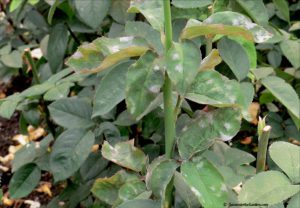Powdery mildew explained

Powdery mildew is one of those annoying plant problems that all gardeners experience at one time or another. I often see it on my squash plants, phlox, bee balm and zinnias. The top photo is of a severe problem in my pumpkin patch a few years ago. No, that isn’t a rare pumpkin variety that has white leaves! The photo below is a close-up of powdery mildew on a rose bush.
It’s difficult to control and hard to understand exactly how it works. I have primarily looked upon powdery mildew as an aesthetic problem more than anything. But here it is time to clean up our gardens for the fall. We need to know whether it’s safe to put infected garden debris into our compost piles.
Fortunately, one of my Master Gardener colleagues (Amy Finkel) recently researched the topic for one of our plant clinic clients. What she learned was so interesting and helpful. Amy decided to write an article about it for our MG newsletter.
I have received permission from both Amy and our MG Coordinator, Tim Kohlhauff, to reprint the information here.
DOES POWDERY MILDEW SURVIVE IN THE SOIL?
Simple Answer: No.
We are all familiar with the symptoms of Powdery Mildew; spots or patches of white to grayish, talcum powder-like growth. The disease is most commonly observed on the upper sides of leaves, but also affects the bottom sides of leaves, young stems, buds, flowers and young fruit. The infected leaves can become distorted, turn yellow with small patches of green, and fall prematurely. Infected buds may fail to open. Powdery Mildew can affect all kinds of plants, including grasses, vegetables, ornamentals, weeds, shrubs, fruit trees, broad-leaved shade and forest trees, lilac, grape, roses and others.
Because the fungus does not need the presence of water on the leaf surface for infection to occur, they can become severe even in warm, dry climates. Powdery mildews are host-specific; they cannot survive without the proper host plant. For example, the species Uncinula necator, which causes powdery mildew on grape and linden, does not attack lilac. Also, Microsphaea alni affects elm, catalpa, lilac and oak, but not turf grass. Just because it’s found on one plant species does not mean it is a threat to other plants in the landscape.
Powdery mildews produce fungal threads called mycelium that grow only on the surface of the plant. The fungi feed by sending root-like structures called haustoria into the top epidermal cells of the plant. They overwinter on plant leaves and debris. In the spring, the mycelium produce spores that can be moved or spread to susceptible host tissue by insects, splashing raindrops, or wind. This is why it’s so important to properly dispose of fallen leaves or debris infected with powdery mildew. Compost temperatures may not be hot enough to kill the fungus.
Many plants have cultivars that have been developed to be resistant or tolerant to powdery mildew. However, once the disease has become a problem, common cultural controls include the following:
- Avoid overhead watering to help reduce relative humidity.
- Remove and destroy all infected leaves and debris. This decreases the ability of the fungus to survive the winter. Do NOT compost.
- Selectively prune overcrowded plants to help increase air circulation.
- Avoid late summer applications of nitrogen fertilizer to limit production of tender new growth which is more susceptible to infection.

